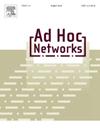Performance analysis of LoRaWAN underground-to-satellite connectivity: An urban underground pipelines monitoring case study
IF 4.4
3区 计算机科学
Q1 COMPUTER SCIENCE, INFORMATION SYSTEMS
引用次数: 0
Abstract
Urban underground pipelines (UUPs) serve the cardiovascular system of our society and the cornerstone of various smart city and industrial applications. Although the leakage of UUPs can be effectively detected and localized by utilizing the measurements of different types of sensors, the reliable transmission of sensor data remains challenging in large-scale UUPs monitoring due to the harsh underground conditions and the complex urban environments. Motivated by recent successful integration of LoRaWAN and satellites, we investigate in this study the feasibility of the massive machine-type communication (mMTC) based sensing approach, which utilizes the underground-to-satellite (UtS) connectivity for monitoring large-scale UUPs. Specifically, we consider two alternative network architectures, i.e., underground direct-to-satellite (U-DtS) and underground indirect-to-satellite (U-ItS), and discuss their pros, cons, and trade-offs. To assess the feasibility and performance of U-ItS and UtS in large-scale UUPs monitoring, we develop the Monte Carlo UtS simulator, featuring realistic UUPs deployments, regional LoRaWAN configurations, semi-empirical propagation models, two gateway deployment approaches, and data aggregation for U-ItS. Our results reveal that U-DtS fails to counter underground propagation losses and shadowing effects in urban environments. However, U-ItS is demonstrated as a promising solution for the reliable wireless monitoring of UUPs, whose performance can be further improved by utilizing data aggregation. Finally, we verify that the transmission success probability of U-DtS and U-ItS is strongly affected by the underground parameters, i.e., the burial depth of devices and the volumetric water content of soil.
LoRaWAN地对星连接性能分析:城市地下管道监测案例研究
城市地下管道(UUPs)服务于我们社会的心血管系统,是各种智慧城市和工业应用的基石。尽管利用不同类型传感器的测量可以有效地检测和定位UUPs的泄漏,但由于恶劣的地下条件和复杂的城市环境,在大规模UUPs监测中,传感器数据的可靠传输仍然是一个挑战。由于最近LoRaWAN和卫星的成功集成,我们在本研究中研究了基于大规模机器型通信(mMTC)的传感方法的可行性,该方法利用地下到卫星(ut)连接来监测大规模UUPs。具体来说,我们考虑了两种可选的网络架构,即地下直接到卫星(U-DtS)和地下间接到卫星(U-ItS),并讨论了它们的优缺点和权衡。为了评估U-ItS和ut在大规模UUPs监测中的可行性和性能,我们开发了蒙特卡洛ut模拟器,具有真实的UUPs部署,区域LoRaWAN配置,半经验传播模型,两种网关部署方法以及U-ItS的数据聚合。我们的研究结果表明,U-DtS不能对抗城市环境中的地下传播损失和阴影效应。然而,U-ItS被证明是一种很有前途的解决方案,用于UUPs的可靠无线监控,其性能可以通过利用数据聚合进一步提高。最后,我们验证了U-DtS和U-ItS的传输成功率受到地下参数的强烈影响,即装置的埋深和土壤的体积含水量。
本文章由计算机程序翻译,如有差异,请以英文原文为准。
求助全文
约1分钟内获得全文
求助全文
来源期刊

Ad Hoc Networks
工程技术-电信学
CiteScore
10.20
自引率
4.20%
发文量
131
审稿时长
4.8 months
期刊介绍:
The Ad Hoc Networks is an international and archival journal providing a publication vehicle for complete coverage of all topics of interest to those involved in ad hoc and sensor networking areas. The Ad Hoc Networks considers original, high quality and unpublished contributions addressing all aspects of ad hoc and sensor networks. Specific areas of interest include, but are not limited to:
Mobile and Wireless Ad Hoc Networks
Sensor Networks
Wireless Local and Personal Area Networks
Home Networks
Ad Hoc Networks of Autonomous Intelligent Systems
Novel Architectures for Ad Hoc and Sensor Networks
Self-organizing Network Architectures and Protocols
Transport Layer Protocols
Routing protocols (unicast, multicast, geocast, etc.)
Media Access Control Techniques
Error Control Schemes
Power-Aware, Low-Power and Energy-Efficient Designs
Synchronization and Scheduling Issues
Mobility Management
Mobility-Tolerant Communication Protocols
Location Tracking and Location-based Services
Resource and Information Management
Security and Fault-Tolerance Issues
Hardware and Software Platforms, Systems, and Testbeds
Experimental and Prototype Results
Quality-of-Service Issues
Cross-Layer Interactions
Scalability Issues
Performance Analysis and Simulation of Protocols.
 求助内容:
求助内容: 应助结果提醒方式:
应助结果提醒方式:


